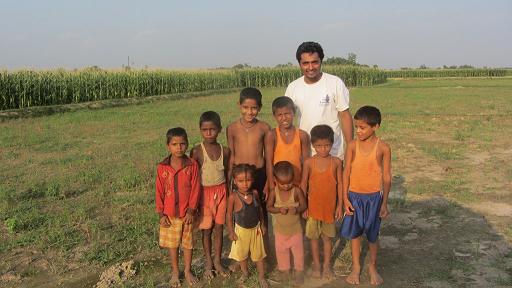-
About
- Our Work
- Get Involved
- Stay Updated
ADS: Future of Nepalese Agriculture
Agriculture in Nepal suffers from years of under-investment, low production, limited research, and petty inputs, technology and services for farmers. By and large, at the beginning of the 20 years Agriculture Prospective Plan (APP) in 1995-96, it was in a worse situation than today. Since we have made progress, but we are still in a low development stage. In general, in spite of two decades of investment, there is only decimal (about 3 percent) progress in Nepalese agriculture.
The overall failure of APP has been coined with 10 years conflict, less stable political government, lack of supporting legislation, poor institutional capacity, very low level of execution of commitments, limited human resources capacity, public-private investment and extremely lacking of coordination (both intra and inter-ministerial).
The government has been developing Agriculture Development Strategy (ADS) to replace APP from 2015 with the concept of agricultural transformation. The ADS is a roadmap of a 20 years vision and a 10-years planning horizon for Nepals agriculture to achieve much higher productivity, competitiveness, inclusiveness, and sustainability while making it more resilient to climate change impacts.
ADS seems highly sound with its vision, a self-reliant, competitive, sustainable and inclusive agricultural sector that contributes to economic growth, improved livelihoods, and food and nutrition security ( Government of Nepal, Ministry of Agricultural Development), but question rises with its description on the various key elements. What does future hold? More of the same I am afraid, because there is little sign that government had recognized the damages that they must learn from the performance of APP in the past. If ADS follows same path, it needs more and more ideal condition in the country and no any faults from APP should be repeated during its project period.
Nepal has already a rich body of policies that are often well formulated and appropriate. But the main problem is the gap between policy and implementation which has leaded the six decades of modern agricultural planning as like bottomless failure as far as agriculture goes. However, this failure is not the result of lack of adequate expertise, the abundance of expertise having high degree of vested interest along with low level of scholar integrity. It would not be wrong; Nepals agricultural policies are made without their serious engagement.
The remarkable vision component of ADS is year round irrigation coverage which is targeted to meet at 80 percent from the current level of 18 percent. The strategy has a target to increase land productivity from $1,700 per hectare to $4,787 per hectare in the next 20 years. Since the average farm size shrunk 36 percent from 1.1 hectares in 1995 to 0.7 hectares in 2010 and percent of holding operations less than 0.5 ha is near to 52. Furthermore, there is no any trusty econometric analysis seen to support all these targeted data. So, whats about farmers involvement in production process? The strategy will not be successful unless it is able to protect small farmers through accessible subsidies, expert inputs, insurance, stable market information and land reforms (equity and efficiency).
The present condition of government budget is merely revenue-centric. Report shows that migrants have been earning about $2,400 and they are sending about $1,600 home annually. ADS has targeted to reach $1833 in the next 20 years from the current value of agricultural labor i.e., $794. It seems clearly that agriculture sector will remain a business related to elderly people and the target will not be achieved in 25 percent GDP from agribusiness. The simple assumption, till that time it will not stop the migration of youth to foreign job markets rather engaged in agribusiness and there is a possibility that other sectors could emerge as major contributors to the GDP.
While most development plans give high priority to agriculture which contributes 35 percent to GDP, government investment in agriculture sector has been only 4.1 percent for this year. ( The HimalayanTimes.com ) When investment is low, we cannot have new technology and programmes to generate employment and grow effectively. In the past, we had neither the technology nor the knowledge, now we have them, but we dont have access to them.
With raising investment, so the government should focus on technological production and infrastructure for the overall agriculture development and need more programs to attract youth towards farming since young people are open-minded attitude to technology, and their different perspective, vision and motivation can contribute to practical solutions. For this, government needs to create the environment to worship the work and labor since it is the necessary condition to attract educated technical youth on merely agriculture sector as their respected domestic industry.
I have been hearing that agriculture is the governments priority since I was a child. Dynamics of stakeholders is changing over time and ADS has been well covered in media but due to lack of public consultation, stakeholders are dissatisfied with the processes. Obviously, two decades is a long time and with completion of ADS, I will be in the age of 40s and do not like to hear response same with APP. If visions of a future based on sustainable and inclusive agriculture are to be realized, and if young people are going to have a place in that future, these problems have to be taken seriously and given much more attention than has been the case in recent policy debate, and in recent research.
About the author
Related Posts
Comments
No comments made yet. Be the first to submit a commentBy accepting you will be accessing a service provided by a third-party external to https://www.ypard.net/
Get in touch
Email: [email protected]
YPARD Global Coordination UnitHosted by AGRIDEA and the Czech University of Life Sciences Prague
Lausanne, Switzerland and Prague, Czech Republic - Our Work


